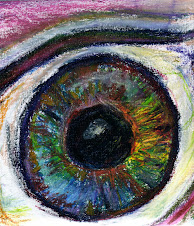Colored Dot Touch is a simple learning center activity for grades K-2.
Learning Related Visual Skills: Laterality & Directionality, visual-motor-integration, and saccadic eye movements
Academic Objective: Students will have independent practice recognizing and naming colors. They will also gain experience observing their partner and recording data using tally marks. The follow-up group activity gives the class an introduction to creating a simple bar graph.
Materials Needed:
- 1 sheet white poster board
- 1 package 1 inch diameter colored dot stickers (at least 4 different colors)
- tape or thumb tacks
- eye patch for each student (make pirate patches as an art project using construction paper and elastic)
Preparation:
- Place the poster board in a landscape orientation so that the top edge is wider than the right/left margin edge
- Stick 10 dots in a column starting about 2 inches from the top and 2 inches from the right side of the board. Vary the colors randomly.
- Stick another 10 dots in a parallel column starting 2 inches from the top and 2 inches from the left side of the board. Line up the dots so that they are spaced evenly as though one dot from each column was in the same horizontal row.
- Create student score sheets. There should be space on the sheet for the names and scores of two students who each get two turns doing the activity.
- Mount the board on a bulletin board in the classroom so that it is easy to reach when the students are standing
Directions:
- Write the names of both partners on the score sheet
- The first partner should stand about a foot away from the board, wearing the eye patch over one eye.
- Using her right hand, she should touch the top dot in the left column and say the color. Then she should use her left hand to touch the top dot in the right column and say its color. Alternating hands, she should proceed down the chart without skipping any of the dots.
- Her partner should observe and count the number of dots she missed as well as the number of times she forgot to switch hands. Record these numbers on the score sheet. Make sure that the score sheet has a place to record each student's performance using the right eye and another place to record the performance using the left eye.
- Switch roles. The recorder should put on an eye patch and do the activity while his partner observes and reports his results.
- Continue switching roles until both partners have done the activity with each eye.
Group Activity Follow-up:
- Create a bar graph to display the results.
- First, compile the results of all the students when they were doing the activity with the each eye. Sort the results according to gender.
- Count the number of times that girls and boys forgot to switch their hands.
- Place the range of the scores along the y-axis.
- Make one colored bar for the boys and another colored bar for the girls. Along the x-axis of the graph, write the labels: "Right Eye", "Left Eye", and "Switching Hands". So, each label should designate a section of the graph that has two bars.
What do the results tell you about your students' learning-related visual skills?
- Students who easily performed this activity probably have good visual-motor-integration, good saccadic eye movements, and a good understanding of laterality & directionality. They probably read easily without losing their place, skipping words or lines, or getting tired. These students are the ones who probably rarely, if ever, make reversals when reading or writing. Most likely they finish worksheets quickly and work in an organized fashion from left to right on the page and from the top to the bottom.
- Students who missed a couple of dots or who neglected to switch their hands once or twice during the activity may demonstrate average performance on paper and pencil tasks or when reading. They could likely improve their efficiency on academic activities by being given more opportunities to exercise their saccadic eye muscles.
- Students who became frustrated and could not complete the activity may have severe deficits of their saccadic eye movements. They probably struggle to learn to read, losing their place frequently and turning in worksheets that look full of holes because of the erratic way that they proceed through the rows and columns. If they were unable to switch hands between columns or if they could not remember to cross the midline to touch the dots on the opposite side of the board, suspect delays in the development of laterality & directionality. They may make frequent reversals when reading and writing. They may express their frustration as confusion. These students would benefit from a comprehensive eye exam.
- Students whose performance on the activity with one eye was weaker than when they did it with the other eye may have a lazy eye, an eye turn, or a difference in the acuities of the eyes that has been undetected so far. These students may need glasses and should be seen by an optometrist or other eye doctor.
Are you a classroom teacher or a home-school teacher/parent? After you try this activity in your classroom, post a comment about your experiences. From time to time, I'll post more learning center activities that rely on learning-related visual skills. I'd like to gather your opinions about them. Thanks in advance.
c. 2009 by Lesley Barker





No comments:
Post a Comment